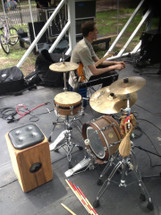Posted by Steve Head on 3rd May 2023
Mastering Cajon Performance: Tips for a Flawless Live Show
If you are a percussionist, chances are that you have come across the cajon at some point. This wooden box has been gaining popularity among musicians and audiences alike in recent years, thanks to its versatility and unique sound. However, playing the cajon in a live setting can pose some technical and logistical challenges. In this article, we will discuss some tips for performing with a cajon in a live setting, and how you can overcome any technical or logistical challenges.
What is a Cajon?
Before we dive into the tips for playing the cajon, let's take a quick look at what it is. A cajon is a percussion instrument that originated in Peru. It is a wooden box that is played by slapping the front surface with the hands, fingers, or various other implements, such as brushes, mallets, or rods. The sound produced by the cajon is deep and resonant, and it can be used in a variety of musical genres, from folk to rock, jazz to flamenco.
Tips for Performing with a Cajon in a Live Setting
Playing the cajon in a live setting requires some preparation and technique. Here are some tips that can help you deliver a flawless performance:
1. Warm-up before the show
Playing the cajon involves a lot of physical activity, especially if you are using your hands. Therefore, it is essential to warm up your muscles before the show. You can do some basic stretching exercises or play some simple patterns to get your hands and fingers ready.
2. Use the right posture
The posture is crucial when playing the cajon. Sit on a comfortable chair or stool, with your back straight and your feet flat on the ground. The cajon should be placed between your legs, with the front surface tilted slightly forward. Make sure you are sitting at the right height so that you can comfortably reach the top of the cajon with your hands.
3. Choose the right spot
When performing with a cajon, it is essential to choose the right spot on the stage. The cajon should be positioned in a place where you can see the other musicians and communicate with them easily. Also, try to avoid placing the cajon in a corner or against a wall, as this can affect the sound.
4. Experiment with different playing techniques
One of the great things about the cajon is that it allows for a lot of experimentation with different playing techniques. You can use your hands, fingers, or other implements to produce various sounds and rhythms. Don't be afraid to try different techniques and see what works best for you and the music you are playing.
5. Practice with a metronome
Playing in a live setting requires excellent timing and rhythm. Therefore, it is essential to practice with a metronome to develop your sense of timing. Start with a slow tempo and gradually increase the speed as you get comfortable with the patterns.
6. Communicate with the other musicians
Playing the cajon in a live setting is not just about hitting the box; it's also about interacting with the other musicians on stage. Listen to their playing and try to complement their parts with your rhythms. Also, communicate with them using gestures or signals to indicate changes in tempo, dynamics, or other musical aspects.
Overcoming Technical and Logistical Challenges
Playing cajons in a live setting can present some technical and logistical challenges. Here are some common problems that you might encounter and some solutions to overcome them:
1. Feedback
One of the most common technical challenges when playing the cajon is feedback. This occurs when the sound from the cajon gets picked up by the microphones and amplified through the speakers, resulting in a high-pitched squeal or screeching noise. To prevent this, make sure to position the microphones correctly, away from the cajon's soundhole, and use a soundproofing shield or foam to absorb the sound.
2. Volume Control
Another technical challenge when playing the cajon is volume control. Since the cajon produces a deep, resonant sound, it can sometimes overpower the other instruments on stage. To avoid this, make sure to balance your playing with the other musicians and adjust your volume accordingly. You can also use a volume pedal or an electronic cajon that allows you to adjust the volume levels easily.
3. Logistics
Logistical challenges can also arise when playing the cajon in a live setting. For example, transporting the cajon can be difficult, especially if you are traveling long distances. To make it easier, invest in a sturdy carrying case or a cajon with detachable legs that can be stored in a compact space. Also, make sure to arrive at the venue early to set up your equipment and perform a soundcheck.
FAQs
Q1. Do I need to use a microphone when playing the cajon in a live setting?
Ans: It depends on the size of the venue and the other instruments on stage. In a small venue or an acoustic setting, you might not need a microphone, but in a larger venue or with louder instruments, you might need to use a microphone to amplify the sound.
Q2. Can I use drumsticks to play the cajon?
Ans: Yes, you can use drumsticks or other implements to play the cajon, but make sure to use the right ones that don't damage the cajon's surface or produce unwanted sounds.
Q3. How can I improve my rhythm and timing when playing the cajon?
Ans: Practice with a metronome or a backing track, listen to different styles of music, and play with other musicians to develop your sense of rhythm and timing.
Q4. How can I prevent my hands from getting tired or sore when playing the cajon?
Ans: Warm up your hands before playing, use the right posture, take breaks between songs, and invest in hand exercisers or gloves that reduce fatigue.
Q5. Can I customize my cajon to suit my playing style?
Ans: Yes, you can customize your cajon by adding snare wires, bass ports, or other accessories that enhance the sound or feel of the cajon.
Q6. How can I make my cajon stand out in a live performance?
Ans: Experiment with different playing techniques, incorporate other instruments or sounds into your playing, and interact with the other musicians on stage to create a dynamic and engaging performance.
Conclusion
Playing the cajon in a live setting can be a challenging but rewarding experience. By following the tips and solutions discussed in this article, you can improve your performance and overcome any technical or logistical challenges. Remember to warm up before the show, use the right posture and playing techniques, practice with a metronome, communicate with the other musicians, and be prepared for any technical or logistical issues that might arise. With these tips in mind, you can master the art of cajon performance and deliver a flawless live show.
As an Amazon Associate, I earn from qualifying purchases. This means that if you click on the link and make a purchase, I may receive a small commission at no extra cost to you. This helps support my work in providing quality content. Thank you for your support!


